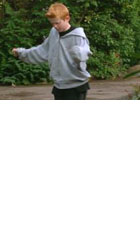
Behavioral Problems 2004
Distributed by Chip Taylor Communications, 2 East View Drive, Derry, NH 03038-4812; 800-876-CHIP (2447)
Produced by Discovery Health Company and Quantum Leap, Ltd.
Directed by Serena Macbeth
VHS, color, 30 min.
Adult
Learning Disabilities, Parenting, Education, Child Development
Date Entered: 12/01/2004
Reviewed by Maureen Puffer-Rothenberg, Valdosta State University, Valdosta, GABehavioral Problems looks at the cases of three British children whose disruptive behaviors have been treated successfully with nutrition, kinesiology or developmental therapy. Part of the Complementary Kids (aka Complementary Childcare) series produced by the Discovery Health Channel, the program shows how alternative treatments have helped children for whom conventional therapies (such as medication) were ineffective.
In Part 1, Nutritional medicine specialist Dr. Brian McDonogh (Eagle Clinic, West Sussex) explains that Attention-Deficit Hyperactivity Disorder (ADHD) is a genetic condition that causes a normal child to be affected by environmental triggers, such as certain foods. Marion Greaves’ teenaged son Freddy provides an illustrative example. Greaves chose to treat Freddy with diet rather than medication because he experienced side effects while taking Ritalin. Freddy tells how he feels when he eats different foods; he agrees with his mother that regulating his diet has helped him control his behavior; he is doing better at school and gets along better with his peers.
In Part 2 David Richardson and his mother Mary talk about his behavioral problems and the results of his therapy with kinesiologist Matthew Schrock. Mary discovered that David was allergic to many foods and changed his diet, but David remained uncommunicative and had trouble getting along with others at school. Schrock explains that his work with David improves the neurological pathways between the right and left brain, helping David to perceive the world around him more accurately.
Part 2 also looks at Ivan Stone, a child whose parents tried developmental therapy as an alternative to constantly increasing his dosages of Ritalin. Ivan’s parents discuss problems he had at school and their reservations about trying an unconventional approach. Therapist Bob Allen (who describes his initial impression of Ivan as “a rubber ball”) explains how stroking Ivan with small paintbrushes helped Ivan develop reflexes that helped him sense himself in space, so he could learn to concentrate and improve his attention span.
McDonogh and Schrock speak of the isolation a child can feel due to perceptual difficulties and warn that alienation in childhood and youth can lead to antisocial behavior, and perhaps even criminality, later in life.
The program can seem a bit disjointed as it alternates quickly and repeatedly between the therapists and parents, or between the parent and child, as one offers a comment and the other’s experience provides an example.
Designed for parents, Behavioral Problems is appropriate for public libraries serving parents and teachers of children with behavioral difficulties related to ADHD, as well as academic libraries serving educators. The program is recommended for parents, teachers and others who wish to consider alternative treatments for children who have ADHD or other behavioral disorders.